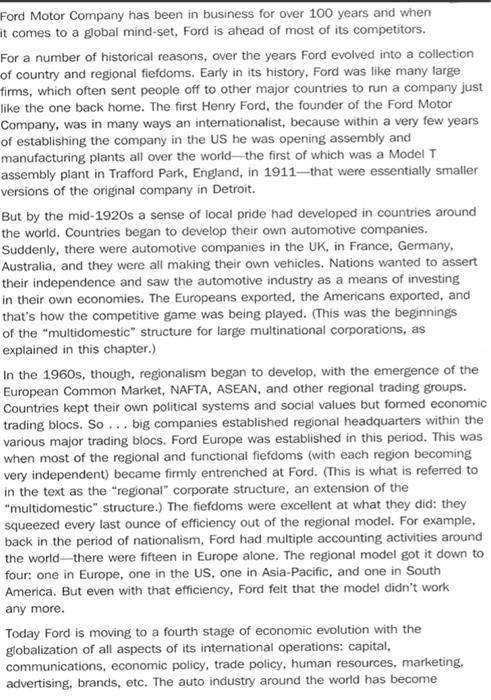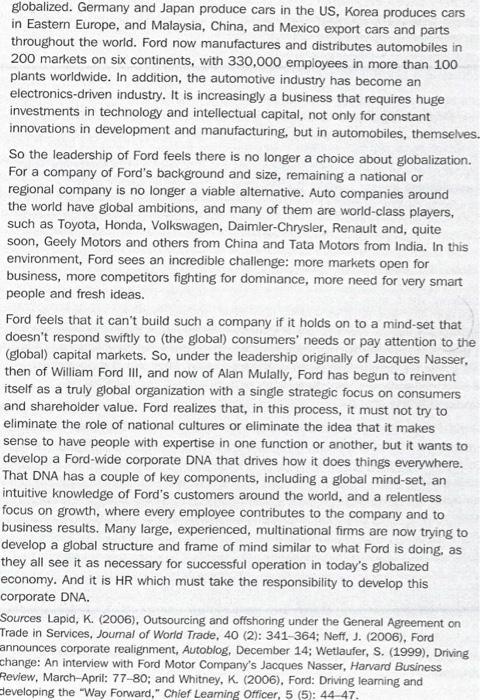Answered step by step
Verified Expert Solution
Question
1 Approved Answer
d) Use 5 dimensions of Hofstede's model of national cultures to assess Ford Motors presence in CHINA AND UAE. Evaluate the national culture of both


d) Use 5 dimensions of Hofstede's model of national cultures to assess Ford Motor’s presence in CHINA AND UAE. Evaluate the national culture of both countries and discuss how they differ from Ford Motor's home county culture, according to Hofstede.
e) Explain how these differences can have an impact on the HRM practices of the company in CHINA and the UAE, support your answer with clear arguments.
Ford Motor Company has been in business for over 100 years and when it comes to a global mind-set, Ford is ahead of most of its competitors. For a number of historical reasons, over the years Ford evolved into a collection of country and regional fiefdoms. Early in its history, Ford was like many large firms, which often sent people off to other major countries to run a company just like the one back home. The first Henry Ford, the founder of the Ford Motor Company, was in many ways an internationalist, because within a very few years of establishing the company in the US he was opening assembly and manufacturing plants all over the world-the first of which was a Model T assembly plant in Trafford Park, England, in 1911-that were essentially smaller versions of the original company in Detroit. But by the mid-1920s a sense of local pride had developed in countries around the world. Countries began to develop their own automotive companies. Suddenly, there were automotive companies in the UK, in France, Germany, Australia, and they were all making their own vehicles. Nations wanted to assert their independence and saw the automotive industry as a means of investing in their own economies. The Europeans exported, the Americans exported, and that's how the competitive game was being played. (This was the beginnings of the "multidomestic" structure for large multinational corporations, as explained in this chapter.) In the 1960s, though, regionalism began to develop, with the emergence of the European Common Market, NAFTA, ASEAN, and other regional trading groups. Countries kept their own political systems and social values but formed economic trading biocs. So ... big companies established regional headquarters within the various major trading blocs. Ford Europe was established in this period. This was when most of the regional and functional fiefdoms (with each region becoming very independent) became firmly entrenched at Ford. (This is what is referred to in the text as the "regional" corporate structure, an extension of the "multidomestic" structure.) The fiefdoms were excellent at what they did: they squeezed every last ounce of efficiency out of the regional model. For example, back in the period of nationalism, Ford had multiple accounting activities around the world there were fifteen in Europe alone. The regional model got it down to four: one in Europe, one in the US, one in Asia-Pacific, and one in South America. But even with that efficiency, Ford felt that the model didn't work any more. Today Ford is moving to a fourth stage of economic evolution with the globalization of all aspects of its international operations: capital, communications, economic policy, trade policy, human resources, marketing, advertising, brands, etc. The auto industry around the world has become
Step by Step Solution
★★★★★
3.35 Rating (155 Votes )
There are 3 Steps involved in it
Step: 1
dCultures around the world are getting more and more interconnected and the business world is becoming increasingly global For managers this means that they should be able to work with a large variety ...
Get Instant Access to Expert-Tailored Solutions
See step-by-step solutions with expert insights and AI powered tools for academic success
Step: 2

Step: 3

Ace Your Homework with AI
Get the answers you need in no time with our AI-driven, step-by-step assistance
Get Started


